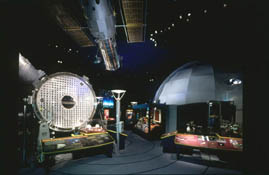
The National Air and Space Museum's newest exhibit, Explore the Universe, features astronomical tools and instruments used throughout history.
Courtesy Eric Long, Smithsonian Institute.
On September 21st, the Smithsonian Institution's National
Air and Space Museum in Washington, D.C., unveiled its newest attraction:
Explore the Universe.
The approximately 4,900-square-foot permanent exhibit chronicles the
history of astronomical observation from ancient times to the current
era. Exhibits in the new gallery run the gamut of astronomical apparatus,
from astrolabes and armillary spheres to adaptive optics.
The exhibit showcases "key elements from three of the
most important telescopes ever made," says curator David DeVorkin. These
include a speculum-metal primary mirror and the long tube from William
Herschel's 20-foot-focal-length telescope, an observing cage and camera
used by Edwin Hubble at the Newtonian focus of the 100-inch reflector
at Mount Wilson Observatory, and the still flight-ready backup mirror
of the Hubble Space Telescope.
Explore the Universe incorporates hundreds of artifacts
and accurate replicas, as well a 1930s-era newsreel, notes, portraits,
snapshots, letters, videotapes, and more. Many featured items are on
loan from other museums, libraries, and observatories; others were donated
by institutions and scientists.
 0
0
Comments
You must be logged in to post a comment.